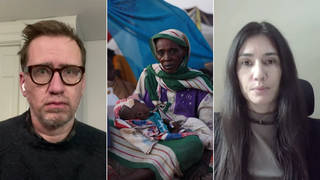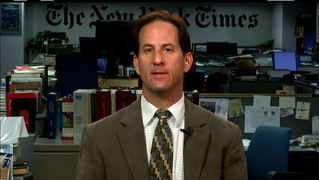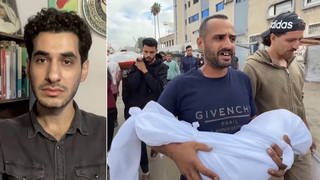
Guests
- Eric LichtblauPulitzer Prize-winning reporter for The New York Times. His new book is The Nazis Next Door: How America Became a Safe Haven for Hitler’s Men.
Investigative reporter Eric Lichtblau’s new book unveils the secret history of how the United States became a safe haven for thousands of Nazi war criminals. Many of them were brought here after World War II by the CIA and got support from then FBI Director J. Edgar Hoover. Lichtblau first broke the story in 2010, based on newly declassified documents. Now, after interviews with dozens of agents for the first time, he has published his new book, “The Nazis Next Door: How America Became a Safe Haven for Hitler’s Men.”
Click here to watch part 2 of this interview.
Transcript
JUAN GONZÁLEZ: We end today’s show with investigative reporter Eric Lichtblau, author of a new book that unveils the secret history of how America became a safe haven for thousands of Nazi war criminals. Many of them were brought here after World War II by the CIA and got support from FBI Director J. Edgar Hoover. Lichtblau first broke the story in 2010, based on newly declassified documents.
AMY GOODMAN: Now, after interviews with dozens of agents for the first time, he has published his new book. It’s called The Nazis Next Door: How America Became a Safe Haven for Hitler’s Men. You can read the prologue on our website. Eric Lichtblau was last on Democracy Now! in 2008, after he and fellow reporter James Risen won the Pulitzer Prize for exposing the NSA’s warrantless wiretapping, despite White House pressure to kill the story. He joins us now from the New York Times D.C. bureau.
Welcome back, Eric, to Democracy Now! This is—it is a fascinating book. You open the book by telling us the story of a man in New Jersey. Why don’t you tell us about him?
ERIC LICHTBLAU: Sure. His name was Tom Soobzokov. He was a guy who had many bosses over the years. He worked for the FBI. He worked for the CIA. And before that, he worked for the Nazi SS. And that opening scene that you’re talking about takes place in the mid-1970s, when people at the Justice Department were starting to first become aware that there were ex-Nazis in the United States. And Soobzokov was one of the people who had come under investigation. He had been living in the United States for 20 years at that point. And he went back to his old handlers at the CIA, somewhat frantically, because the heat was really being put on him over his past and these accusations that he was in fact a Nazi, which he vehemently denied. And in the declassified documents that I looked at from the CIA, there’s memo after memo where the CIA is recounting these frantic phone calls and conversations with Soobzokov, where he’s saying, you know, “What am I going to do?” And the CIA is almost as frantically then meeting amongst themselves to say, “We’ve got a little problem on our hands here, and it’s going to get worse.”
JUAN GONZÁLEZ: And, Eric, talk about the CIA head, Allen Dulles, brother of John Foster Dulles, the secretary of state under Eisenhower, and his role in shaping this policy.
ERIC LICHTBLAU: Right, right, yeah, Dulles was one of the intelligence titans of the 1950s, one of the original cold warriors. And he was someone who believed that there were, quote-unquote, “moderate Nazis,” his words, who the U.S. could use to its advantage in the Cold War. And he actively recruited them himself and, in a number of cases, intervened on their behalf when they were facing accusations about their past, about their involvement in Nazi war crimes. And he and J. Edgar Hoover were really the two linchpins in this, in developing this strategy of recruiting ex-Nazis as cold warriors, as anti-Soviet assets who, they believe, could gather intelligence for the U.S.
Now, the irony is that a lot of these guys, a lot of these ex-Nazis used as spies by the CIA, by the FBI, really turned out to be bad spies. There are all sorts of files that I examined showing that they—not shockingly in hindsight, that the Nazis were found to be liars and cheats and embezzlers, and in a couple cases they were even found to be Soviet double agents. So, not only do they have the incredible baggage of being Nazis, but they were not even good spies.
AMY GOODMAN: I mean, the story you tell of Allen Dulles meeting with Nazi General Karl Wolff in Switzerland—
ERIC LICHTBLAU: Right.
AMY GOODMAN: He was the number two man, right, for Himmler. Explain the deal that they were making, and then talk about the scientists that were recruited. I just flew back from Austria and sat next to a man who lives in Vienna, who grew up in northern New Jersey, and he said his father was brought from Germany by the CIA to northern New Jersey because he was a scientist, and they wanted him here, not in Russia.
ERIC LICHTBLAU: Right. Well, starting with the scientists, we brought over, under something called Program Paperclip, like 1,600 Nazi scientists. These were engineers, doctors, jet propulsion experts, things like that. The most famous among them was Wernher von Braun, who was one of the guiding hands in getting us to the moon in 1969. And officially, under the policies put in place by Truman and Eisenhower after the war, these were not supposed to be, quote-unquote, “ardent Nazis,” whatever that may mean. But, you know, in fact, these were people who were directly involved in, for instance, running slave labor factories, where thousands and thousands of people died in making Hitler’s rockets. These were doctors who were involved in medical atrocities. They then found homes in the United States as American scientists. Many of them became U.S. citizens. Many of them became honored for their work in the United States.
As far as Allen Dulles, who you asked about, yeah, his role in having negotiations and conversations with Nazis began even before the war was over, believe it or not. A few months before the war [ended], there was a meeting that I talk about in the book where he met at a safe house in Zurich with Himmler’s ex-chief of staff, who was trying to save his own skin. He realized the war was about to be over in a few months, and he was understandably afraid of being charged in all sorts of war crimes. This was Himmler’s chief of staff. He was involved in setting up the train network that led millions of Jews and others to their deaths. And Dulles thought that this general, General Karl Wolff, could help end the war earlier. As it turned out, they ended the war maybe two weeks earlier in the region in Italy that Wolff controlled. But as part of these negotiations, they were sipping Scotch over a lovely fireside in Zurich. For months and months after the war, even for the first couple of years, Dulles really effectively protected General Wolff, Himmler’s ex-chief of staff, from war crimes charges. And Wolff went from being a chief defendant, one of the top Nazi defendants at Nuremberg, to being merely a witness, and served virtually no time in prison. In fact, even when he was nominally a prisoner as a POW, he was allowed to wear a gun. He went boating on the weekends in Austria. He led sort of a charmed life after the war, thanks to the help of Allen Dulles, who went on to become the first director of the CIA.
JUAN GONZÁLEZ: Eric, one of the heroes of your stories is—of your book is a reporter named Chuck Allen—
ERIC LICHTBLAU: Yeah.
JUAN GONZÁLEZ: —who first began exposing this underground railroad of evildoers into the United States, but who was, at first, for many years, ignored. Could you talk about him?
ERIC LICHTBLAU: Right, right. I had never heard of Chuck Allen when I started my research, but he became sort of a hero of mine as I was writing this book. He was a left-wing journalist in the early 1960s, writing for obscure Jewish publications, sometimes communist-leaning publications. And he started writing exhaustively in the early 1960s about the fact, which was really unknown at the time, that there were Nazis and Nazi collaborators living openly in the United States. He wrote in 1963 an exhaustive, 40-page piece for a magazine called Jewish Currents, which was affiliated with the Communist Party. And in it, he documented the role of, for instance, a bishop in Chicago and a State Department analyst who had clear ties to the Nazis in atrocities.
And he was not only ignored, as you say, sort of written off as some left-wing kook, but at the FBI, they started paying attention, to the point that J. Edgar Hoover ordered him to be wiretapped for a number of years. And you had FBI agents trailing him as he would try and gather evidence on Nazi atrocities by people inside the United States. So he was seen as a subversive, as a communist plant, and was either ignored or shunned or actually retaliated against for writing these things in the 1960s. And this was a time when really no one else noticed or cared that there were, at that point, hundreds, thousands of Nazis living openly in the United states.
AMY GOODMAN: So he was being—while he may have been ignored by the public, he was being harassed by the FBI—
ERIC LICHTBLAU: Absolutely.
AMY GOODMAN: —at the same time that the FBI and the CIA were protecting these Nazis. Another amazing part of the story is how so many of those in the concentration camps afterwards, the Allies were running these concentration camps—
ERIC LICHTBLAU: Right.
AMY GOODMAN: —and the Jews were there. And often, the Nazi POWs in these camps would be put in charge of them—by the United States.
ERIC LICHTBLAU: Right, right. No, I’m glad you asked about that. I mean, that was probably the single most striking thing to me in my research. There were a lot of alarming things that I came across that I didn’t know when I started writing this book. But I think the most repugnant of all the repugnant things was the treatment of the survivors, not just Jews, but communists, gays, Roma and others who survived the Holocaust, but for months, and in some cases a couple of years, after the end of the war were still kept inside the concentration camps themselves, under—behind barbed wire, under armed guard, sometimes under the supervision of other Nazi POWs.
And it was—I learned it was General Patton, a war hero, “Old Blood and Guts,” they called him, who oversaw the camps. He was the supreme Allied commander after the war. And he—I looked at his journals. He was a virulent anti-Semite. And there was a scathing report to Truman by an emissary of Truman’s from the University of Pennsylvania, Earl Harrison, that compared the camps that the United States was running after the war to the Nazi concentration camps. Harrison wrote that the only difference is that we’re not exterminating the Jews, which, you know, think of that in hindsight. Patton—
AMY GOODMAN: Eric—
ERIC LICHTBLAU: Yes?
AMY GOODMAN: Eric Lichtblau, we have to end the show, but we want to—
ERIC LICHTBLAU: Sure.
AMY GOODMAN: —ask if you can stay, and we’ll put part two online at democracynow.org. The Pulitzer Prize-winning reporter for The New York Times, his new book, published this week, The Nazis Next Door: How America Became a Safe Haven for Hitler’s Men. You can read the prologue at democracynow.org.
I’ll be in Oslo, Norway, at Norway Social Forum, speaking Saturday, November 1st. Check our website at democracynow.org.












Media Options